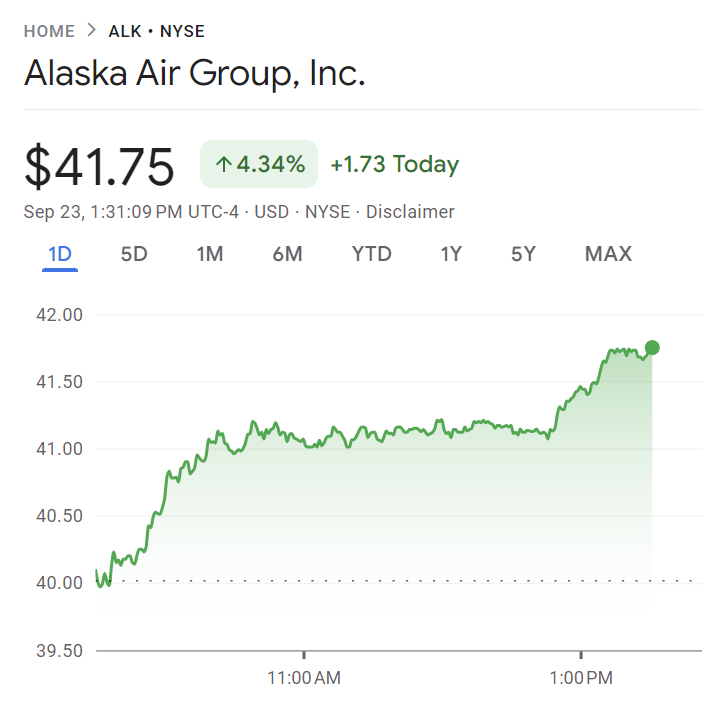Alaska Airlines is raising $1.5 billion in debt against its Mileage Plan frequent flyer program, which it expects to use in part to pay down the $900 million in Hawaiian Airlines debt it’s taken on as part of acquiring the Honolulu-based carrier.
- Mileage Plan is now controlled by a Cayman Islands subsidiary, AS Mileage Plan IP Ltd.
- It’s able to borrow against the program’s future revenue streams, primarily from Bank of America but also from other partners (like Cartera Commerce which runs the shopping portal, Rewards Network which runs Dining, and Bilt which offers points transfers).

Last month, JetBlue announced a big deal to raise cash against its frequent flyer program and the stock tanked. In a day so far where the markets are flat, Alaska stock remains up sharply.

Hawaiian Miles will transfer 1:1 into Alaska at will in a matter of days. Alaska will offer reciprocal status matching with Hawaiian. And there’s a great opportunity to acquire credit cards from both carriers while the loyalty programs remain separate (and Hawaiian cardholders can transfer points to and from other members free, so if your friends and family get Hawaiian cards their points can end up in your Alaska account).
During the pandemic, United, American and Delta raised $6.5 to $10 billion apiece against their loyalty programs. Taking on debt against future co-brand credit card income streams was a much bigger play than pre-selling miles to bank partners during the financial crisis (structured as debt), which is the play Southwest Airlines engaged in during the pandemic era again.
In fact, Hawaiian Airlines had issued approximately $1 billion in senior secured notes against HawaiianMiles at both 5.75% and 11%. Alaska sees the opportunity to lower its borrowing cost here – Mileage Plan is going to be even bigger going forward.


It would be interesting to know how much value is created by having a borrower with a higher credit rating replacing the other higher interest debt. 11% notes seem quite high.
What could possibly go wrong? OK, that’s a rhetorical question. Once the airline has money in hand, it has much less incentive to maintain the value of your points.
Speaking of.Hawaii, long-time mutual acquaintance Charles/Chuck Blaisdell (cblaisd) died of cancer. May he rest in peace and condolences to his family.
@GUWonder I did hear that very sad news 🙁 Chuck was the original FlyerTalk senior moderator with me, to which Carol and Brian Cohen were later added.
Debt is quite the opposite of a “windfall”!! You need to study economics 101. Debt is not free money or an unexpected financial gain.
Here’s a brief explanation:
1. Repayment obligation: Unlike a windfall, which typically refers to unexpected income or assets you get to keep, debt must be repaid.
2. Interest costs: Debts accrue interest, meaning you end up paying back more than you borrowed.
3. Financial burden: Debt creates a financial obligation that can strain your budget and limit future financial flexibility.
4. No increase in net worth: While debt may provide temporary liquidity, it doesn’t increase your overall net worth since it’s balanced by an equal liability.
5. Risk: Taking on debt involves risk, especially if your ability to repay changes due to unforeseen circumstances.
This is nothing more than debt collateralized by future revenues from the selling of miles, i.e. prepaid travel, backed by a contract.
The program itself (without the airline) is worthless and unsellable: see what happened to Aeroplan etc.
Mileage programs need to be regulated at a minimum by SEC requirements so that the debt is not just a promise but an obligation. Where does this debt fall as far as repayment in case of bankruptcy? Are the holders of the debt instruments out of a lot of their money if the airlines decide to devalue their mileage programs to a point where people no longer participate to any great degree? Mileage programs are no longer freebies and need to be treated in a different way. Investors need to have hard facts about the risk. I know, any careful investor would steer clear of all airlines.
They are already ripping off their program members charging more than American for partner awards in Prem cabins.Might as well go all out full throttle Delta style charging 500 k per award each way and making back their outlay quicker with the Alaska cultists who never complain no matter what they do
Shut your damn mouth, GU. Chuck hated you with a passion. He wanted you banned a long time ago, and you know it.
Christmas Ghost should know that it is no skin off my back and not news to me. Cblaisd was suffering for quite some time, and it got much worse this year. There is sadness to be found in such suffering. And his loved ones and other acquaintances also deserve condolences regardless of how he felt about anyone.
Has Hawaiian seen a big increase in credit card applications for its loyalty program affinity card since the de facto acquisition by AlaskaAir came into sight?